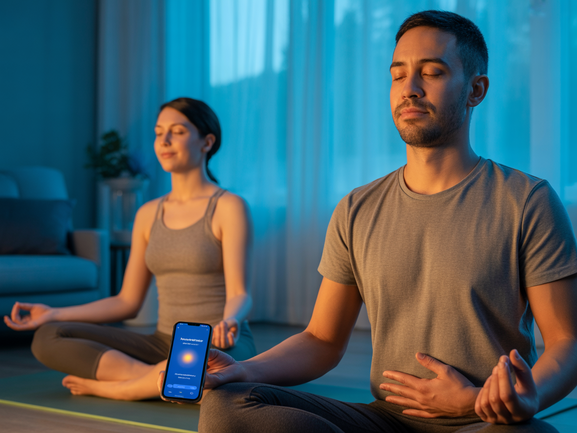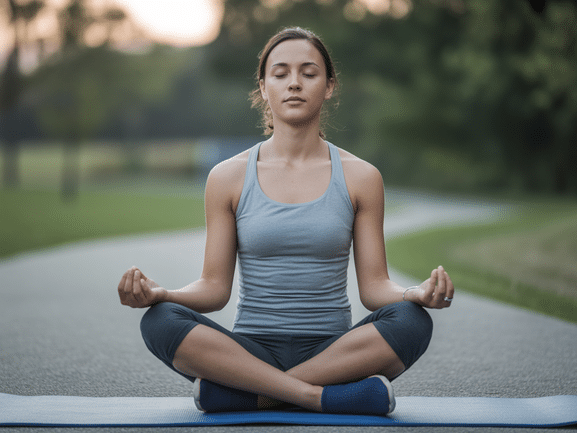7 Simple Meditation Tips That Actually Reduce Stress Fast
Picture this: It’s 6 PM, you’re stuck in traffic after a 10-hour workday, your phone won’t stop buzzing with notifications, and tomorrow’s deadline is looming over your head like a dark cloud. Sound familiar? If you’re nodding along, you’re definitely not alone.
The good news? Meditation for stress relief doesn’t require you to sit in lotus position for hours or chant in ancient languages. In fact, the most effective mindfulness techniques can be practiced anywhere, anytime – even in that traffic jam.
Why Your Brain Craves Meditation (Science-Backed Facts)
Before diving into the techniques, let’s talk about what actually happens in your stressed-out brain. Recent neuroscience research shows that regular meditation practice literally reshapes your brain structure, reducing the size of the amygdala (your stress center) while strengthening the prefrontal cortex (your rational thinking center).
Moreover, a 2023 study published in the Journal of Health Psychology found that just 10 minutes of daily meditation practice can reduce cortisol levels by up to 23% within eight weeks. That’s your body’s primary stress hormone taking a much-needed chill pill!
7 Powerful Meditation Techniques for Instant Stress Relief
1. The 4-7-8 Breathing Method
This technique, popularized by Dr. Andrew Weil, works like a natural tranquilizer for your nervous system. Here’s how:
- Inhale through your nose for 4 counts
- Hold your breath for 7 counts
- Exhale completely through your mouth for 8 counts
- Repeat 3-4 cycles
Perfect for those moments when anxiety hits unexpectedly. Try it before important meetings or when you’re feeling overwhelmed.
2. Body Scan Meditation
This mindfulness technique helps you reconnect with your physical self while releasing tension. Start at the top of your head and slowly move your attention down through each body part, noticing any sensations without judgment.
The beauty of body scan meditation lies in its simplicity – no special equipment needed, just 5-10 minutes of your time.
3. The 5-4-3-2-1 Grounding Technique
When stress spirals out of control, this technique brings you back to the present moment:
- Notice 5 things you can see
- Identify 4 things you can touch
- Listen for 3 sounds around you
- Find 2 scents you can smell
- Notice 1 thing you can taste
4. Walking Meditation
Can’t sit still? No problem! Walking meditation combines gentle movement with mindfulness practices. Focus on the sensation of your feet touching the ground, the rhythm of your steps, and your breathing pattern.
5. Loving-Kindness Meditation
This technique involves directing positive thoughts toward yourself and others. Start with “May I be happy, may I be healthy, may I be at peace,” then extend these wishes to loved ones, neutral people, and even difficult individuals in your life.
6. Visualization Meditation
Close your eyes and imagine your ideal peaceful place – maybe a serene beach, a quiet forest, or a cozy cabin. Engage all your senses: What do you see, hear, smell, and feel in this space?
7. Mantra Meditation
Choose a simple phrase or word that resonates with you. Popular options include “Om,” “Peace,” “I am calm,” or “This too shall pass.” Repeat it silently or aloud, allowing the vibration to center your mind.
Breaking the Biggest Meditation Myths
Let’s address some common misconceptions that might be holding you back:
Myth 1: “I need to clear my mind completely.”
Reality: Thoughts will come and go – that’s totally normal! The goal is to observe them without getting caught up in them.
Myth 2: “I don’t have enough time.”
Reality: Even 3-5 minutes can make a difference. You probably spend more time scrolling social media!
Myth 3: “Meditation is religious.”
Reality: While meditation has spiritual roots, it’s primarily a mental training technique backed by extensive scientific research.
How Technology Can Enhance Your Practice
While traditional meditation is powerful, modern meditation apps can provide structure and guidance, especially for beginners. Quality apps offer:
- Guided sessions tailored to your experience level
- Progress tracking to maintain consistency
- Variety in techniques and lengths
- Reminders to help build the habit
The Vitalizen app stands out by combining guided meditation with yoga practices, creating a comprehensive wellness experience. Whether you have 5 minutes or 30, there’s a session designed to meet your needs.
Building Your Daily Meditation Habit
Consistency trumps duration every time. Here’s how to make meditation stick:
- Start small: Begin with 5 minutes daily
- Same time, same place: Create a routine
- Be patient: Benefits accumulate over time
- Track progress: Use apps or journals
- Find community: Join meditation groups or online communities
Remember, the goal isn’t perfection – it’s progress. Some days will feel easier than others, and that’s completely okay.
Frequently Asked Questions
How long should I meditate as a beginner?
As a beginner, start with just 5-10 minutes daily. This duration is manageable and helps you build the habit without feeling overwhelmed. You can gradually increase the time as you become more comfortable with the practice.
What’s the difference between meditation and mindfulness?
Meditation is a formal practice where you set aside specific time to train your mind, often using techniques like breath focus or mantras. Mindfulness is a state of awareness that can be practiced throughout your day – being fully present while eating, walking, or even washing dishes.


